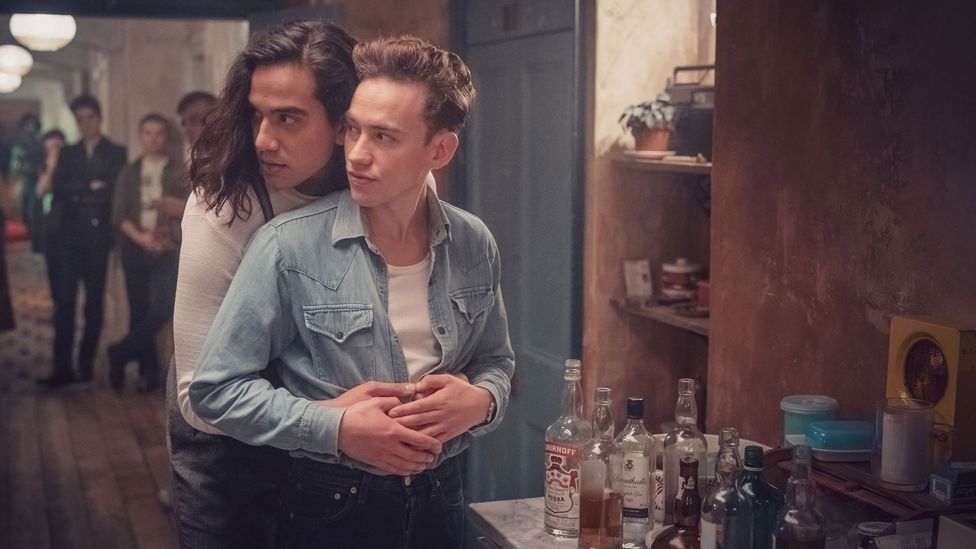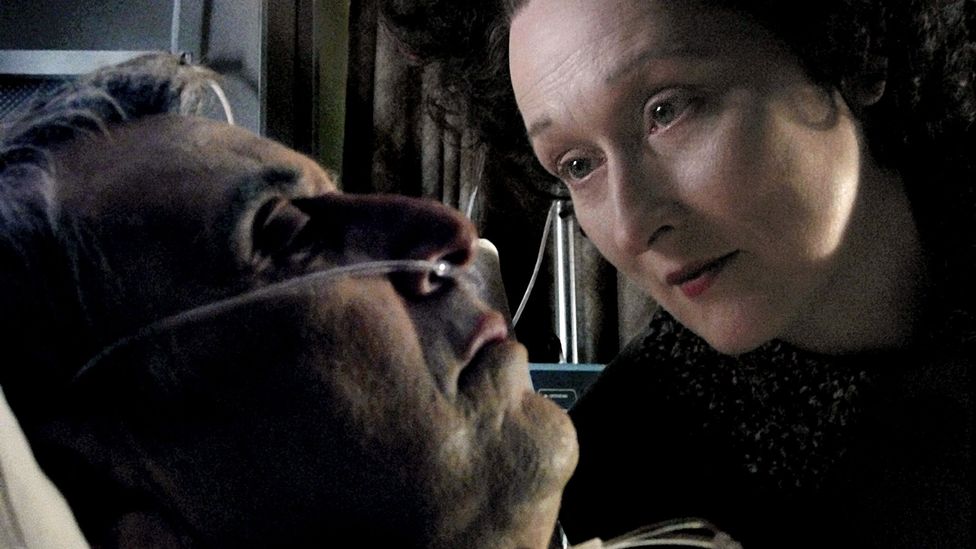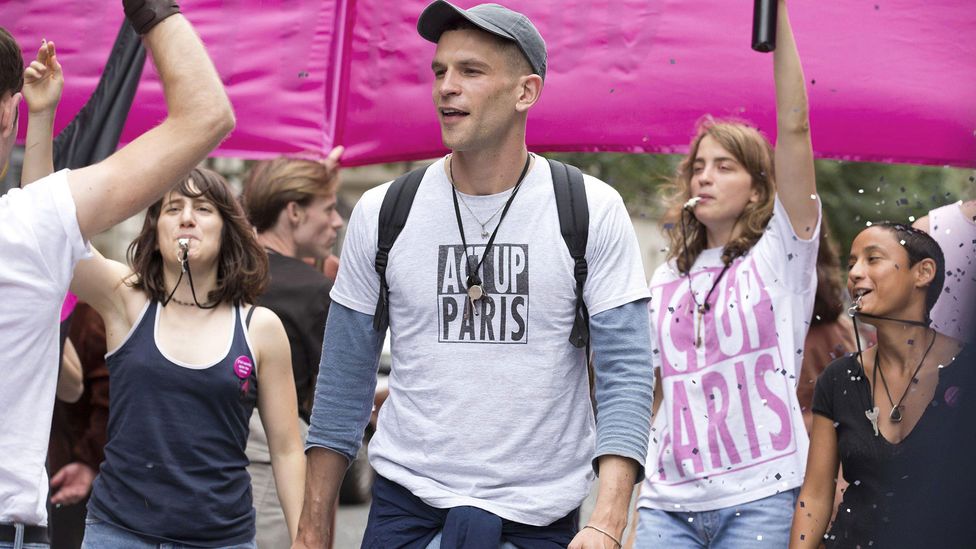It's 1983, and a bookish 20-year-old stands in his local newsagents, flicking through the magazine rack. The shop is in Oxford, amid a quiet suburb of red-and-grey brick terraced houses, a half-mile or so's walk from Oxford University's Worcester College, where he has studied for the past two years. He feigns exaggerated interest in a few periodicals and glossies, but he’s there, really, for a single purpose – to buy the latest copy of monthly gay magazine Him. Why his mission is clandestine needn't be elaborated.
More like this:
– One of the greatest ever TV dramas
– Nine TV shows to watch in January
– The play that raged against Reagan's America
His purchase nervously secured, he retreats outside into a wall of heat. It's a gorgeous, sweltering June day, with a symphony of birdsong carried by the breeze. He wanders down the street, prize in hands. He hadn't dared take the time to look at the magazine in the shop, but now, the coast is clear. The cover is illustrated by the great homoerotic artist Oliver Frey with a picture of men boiling in a test tube, accompanied by a banner that shouts at him from the across page. "AIDS DEATH PLOT PANIC."

It's a Sin tells the story of the UK Aids crisis from the perspective of a group of young gay men coming of age in the 1980s (Credit: Channel 4)
This episode is recalled to me by writer Russell T Davies over Zoom from his flat in Cardiff, Wales. As one might expect of the dramatist behind some of Britain's most acclaimed television series– the eerily prescient Years & Years, the Bafta-nominated A Very English Scandal, the Bafta-winning resurrection of Doctor Who – he paints a vivid image. It's this moment from his own youth that was the spiritual root of his latest series, It's a Sin. "I stood there and thought, 'oh, it's real'," Davies recalls. "But here I am, right, almost 40 years later, writing this entire drama actually about that moment in the street."
The show centres on a commune of five young people, four gay guys and a girl, living together in the 'Pink Palace', a grotty London party house with sticky carpets and flaking wallpaper. It begins in the early 1980s. Having escaped their small-town enclaves for the Big Smoke, they party every night like they've nothing to lose, the sex as copious as the booze. However looming on the horizon unbeknown to them, but all too obvious to us, is a medical catastrophe: Aids.
The lineage of Aids fiction
Aids fiction has a long and illustrious lineage, with the greatest abundance of, and certainly the most internationally-recognised, works, having emerged from the United States, the epicentre of the virus in the 1980s. However few dramatists have wrestled with it in a British context – and fewer, if any, so extensively as Davies does in It's a Sin. The resonances the series shares with its US screen predecessors, nonetheless, is ever-apparent. Like Norman Rene's 1989 film Longtime Companion or, more recently, Yen Tan's 2018 drama 1985, Davies's series weighs heavily with tragic inevitability. We watch the ensemble live, make mistakes, and indulge the hedonistic desires of their early 20s, as characters in any other youth drama – only with death hanging over them as an ever-present threat. The clock ticks. The virus has no rhyme or reason: someone perishes after sex with a single partnerr, while others are flabbergasted by negative test results, having exhausted their sexual options in the bars. Every time Ritchie (a spellbinding Olly Alexander) takes a boy home, it's a roll of the dice.
One early montage, in which Ritchie rattles off a list of the then-debated causes of the virus, echoes the great monologue in Larry Kramer's seminal Aids play The Normal Heart, in which the character Mickey, an activist and public health worker, laments the endless theories about the virus's origins ("I've written about every single one of them," he exasperatedly says).

Tony Kushner's two-part play Angels in America, filmed for TV with Al Pacino, is one of the totemic US works of Aids fiction (Credit: Alamy)
Ritchie, embodying the pleasure-is-politics ethos of many gay men at the crisis' beginning, is tired, too, of the endless noise, refusing to let his promiscuity, which is his freedom, succumb to paranoia. And like Tony Kushner's Angels in America, the series' sweeping, decade-long timeline gives us a profound sense of how the ensemble is changed. By the end, their youthful vitality is coated with a stubborn frost, sometimes thawed by cups of milky tea and consoling cuddles.
While It's a Sinis the first British series to explore the Aids crisis on a societal level, the virus has echoed through British popular culture since at least the late 80s. The 1987 TV drama Intimate Contact, for example, relayed the impact of an individual Aids diagnosis within a heterosexual marriage. Meanwhile, the first time Davies saw HIV depicted on screen – or rather the suggestion of HIV – was during an infamous 1988 storyline in the country's popular primetime soap opera EastEnders, involving its leading gay character Colin. "They led us on a dance with Colin (Michael Cashman) – he started to fall ill, and the whole country was waiting for him to contract HIV in quite a ghoulish way... it turned out he had MS." The year prior, Colin was also a participant in the first gay kiss in a British soap opera. The soaps, like EastEnders, boasted enormous pull with the viewing public at the time, Davies recalls. "[They were] a much more powerful cultural artefact [in those days]. Then, it was the show to look at, the show to give you cues on how to react."
In a subsequent storyline beginning in January 1991 and ending 13 years later with his death from complications of Aids, Mark Fowler (Todd Carty), who was heterosexual and married, contracted the virus. He faced significant prejudice, not least from the show's iconic matriarch, Peggy Mitchell (Barbara Windsor). They eventually reconciled. "For her to learn that she was wrong was a really powerful lesson," says Davies. "Of course, at that stage, they did a very wise thing, which was to say 'look, this isn't affecting just gay people, this is affecting straight people as well'. They ended up telling a very, very powerful story."
The phantom of the virus was also present in Davies' earlier, other explicitly queer works, set after the crisis had begun to abate. His pioneering late-1990s drama Queer as Folk featured a character, Phil, killed by a drug overdose during a hook-up. It may not be literalised as Aids, but gay sex, here, leads to death. Meanwhile 2015's Cucumber, which centres on a group of aging gay men, considered how the memory of Aids lingers for the generation who lived through the crisis at its peak. Their familiarity with queer death is emphasised at the funeral of Lance (Cyril Nri), murdered after sex by a closeted man curdled with shame. "I thought we’d seen the last of this," says Cliff (Con O'Neill), "funerals at too young an age. I thought we'd beaten it". They crack jokes and gawp at Grindr boys as if sat in a bar on Canal Street.
What there is left to add
These days, American, British or otherwise, the very concept of the Aids drama may provoke the question among some: is there anything new to add? That's because works such as The Normal Heartand Angels in America are the monoliths of LGBTQ+ fiction, contributing to perceptions that the epidemic has been dramatically exhausted. "In some ways every gay writer – and you don't have to be gay to write about HIV, of course – stands in the shadow of[those texts]," says Davies. "Because here they are, being revived all the time. They are immense and brilliant." He points to the upcoming revival of The Normal Heart planned at London's National Theatre [as and when coronavirus restrictions lift] and the hit production of Angels in America, that premiered there in 2017 before moving to Broadway. However the flipside of their brilliance is that it's perhaps easier to understand why a more exhaustive rendering of the British crisis has not hitherto emerged. "I was sitting in commissioners' offices saying 'you haven't seen this'," Davies explains of trying to get It's a Sin greenlit, "which is a very hard thing to argue when you're asking for millions of pounds".

2017 French film 120 BPM, about the Paris branch of activist group ACT UP, has been one of the most impactful Aids dramas of recent times (Credit: Alamy)
Davies says his show is consciously interacting with all its forebears while also being distinct from them. "I’m very well versed in Aids fiction. I'm not saying I've seen everything… but I probably have, because it interests me. It's my life," he explains. "I could write an essay about how much of It's a Sin is dancing with other pieces of work, and finding different ways to tell things that have been done before, because I didn't want to repeat. I had things of my own to say that I felt hadn't been said, too."
Certainly, while bearing comparison with those totemic US Aids dramas, it also brings out the peculiarities of how the virus impacted British culture and society, specifically. One of the myths floating around London in the series' first episode, for example, is that only Americans carry the virus. "Oh yes, it was a real thing. It allowed us to feel quite safe, that it was talked about as American," explains Davies. "We literally said 'don't sleep with Americans'. It was that simple." Another episode covers the forced isolation of an Aids victim, flimsily justified under the country's 1984 Public Health Act, in a dingy hospital ward. "He chose to be a part of that cesspit," argues the officer delivering the news to his heartbroken mother. Aids is a novel term to her; moments prior, she had discovered it was a death sentence. It's a Sin does not look kindly upon the actions, or inaction, of the state.
What's clear is that while the centring of North America in Aids fiction is understandable – given the epidemic there counted for the lion's share of HIV infections and deaths in the West – each country and area of the world has its own important stories to tell – and it is heartening that the canon of Aids fiction continues to grow and extend its global reach.
Stories all over the world
Looking from Britain to Europe, more widely, an especially impactful recent Aids drama was the 2017 French film 120BPM, which told the story of ACT UP Paris, an offshoot of the New York activist group co-founded by Larry Kramer in 1987 (and of which its director, Robin Campillo, was a member). Parts of the film, wherein we observe the activists debating the efficacy of their protest methods, evoke the aesthetic style of cinéma vérité, matching the film's urgency with blunt realism. Again, echoing the established conventions of Aids fiction, it conveys a sense of horrifying inevitability. This isn't the only example of France's epidemic on film, implicit or otherwise: director Paul Vecchiali covered it as far back as 1988's Once More, and an entire thesis could be written on Aids allegories in contemporary French queer film.
"story" - Google News
January 22, 2021 at 03:00PM
https://ift.tt/2M5PoBO
Aids on screen: the forgotten stories of the other pandemic - BBC News
"story" - Google News
https://ift.tt/2YrOfIK
https://ift.tt/2xwebYA
Bagikan Berita Ini














0 Response to "Aids on screen: the forgotten stories of the other pandemic - BBC News"
Post a Comment